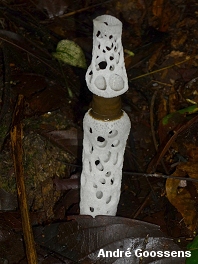| Major Groups > Stinkhorns > Staheliomyces cinctus group |

|
Staheliomyces cinctus species group [ Basidiomycota > Agaricomycetes > Phallales > Phallaceae > Staheliomyces . . . ] by Michael Kuo Take a slice of what Americans call "Swiss" cheese, roll it up, pinch off one end, and slide a slimy brown napkin ring over the top. And, I almost forgot, plant the whole thing in an egg shell you've partially buried. One last thing: make sure the slime reeks to high heaven. Apparently limited to South and Central America, species of Staheliomyces grow from soil that is rich with decomposing plant remains. By present definitions there are roughly half a dozen species in the genus, five of which are named and are separated as phylogenetic species, as well as by their physical features—including the color of the volva, the shape of the brown slime belt, and the shape of the sterile portion above the slime belt. See Cabral and collaborators (2022) for a key to the species. If you have found one of these amazing mushrooms, I would love to make this page more scientific by studying your specimen! Please send me an email at if you would be interested in preserving the mushroom and sending it for study. Description: Note: I have not collected any Staheliomyces species, nor have I studied preserved specimens; the description below is based on photos (sent to me in emails) and the literature cited. Ecology: Saprobic; growing terrestrially in soil rich with decomposing plant debris; appearing in rainy seasons; Central America and northern South America. Immature Fruiting Body: Like a whitish or purplish "egg" attached, at the base, to rhizomorphs; when sliced revealing the stinkhorn-to-be encased in a gelatinous substance. Mature Fruiting Body: A hollow, white, cylindric structure up to about 15 cm high, featuring conspicuous pits and holes; with a belt-like band, roughly 1–3 cm wide, of brown spore slime positioned between the midpoint and the apex (in some species the band is constricted at the top and bottom); upper portion cylindric, slightly tapered, or quickly tapering (flame-shaped); base encased in a whitish or purplish volva. Microscopic Features: Spores 3–4 x 2–2.5 µm; subcylindric to subellipsoid; smooth; hyaline in KOH. Sphaerocysts of the pseudostipe up to 60 µm wide; subglobose or irregular; hyaline in KOH. Hyphae of the volva without clamp connections. REFERENCES: E. Fischer, 1921. (Zeller, 1948; Saenz & Nassar, 1982; Miller & Miller, 1988; Calonge, Mata & Carranza, 2005; Baseia et al., 2006; Schause, 2021; Cabral et al., 2022.) I have not collected or studied these mushrooms. This site contains no information about the edibility or toxicity of mushrooms. |
|
|
Cite this page as: Kuo, M. (2022, August). Staheliomyces cinctus species group. Retrieved from the MushroomExpert.Com Web site: http://www.mushroomexpert.com/staheliomyces_cinctus.html © MushroomExpert.Com |
